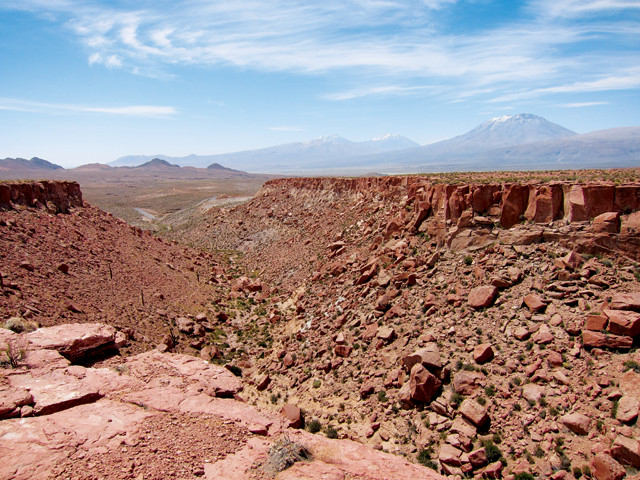
by Julia Rosen Tuesday, June 16, 2015

Wind may dramatically reshape canyons, both on Earth and on Mars. Credit: Noah J. Finnegan.
As a force of nature, wind is usually afforded less respect than water. Sure, it can topple trees and, in extreme cases, peel roofs off houses. But it can’t carve mighty canyons like water can — or can it? A new study suggests that geologists may have underestimated wind’s role in shaping valleys in arid environments, both on Earth and on Mars.
Led by Jonathan Perkins of the University of California at Santa Cruz, scientists headed to the Andes Mountains in northern Chile where they took advantage of a naturally occurring experiment. Along a single escarpment, they found almost 50 river canyons, some of which faced the full brunt of the prevailing winds while others lay in the wind-shadow of a tall ridge.
When they compared the two sets of valleys, they found that wind-affected canyons were longer, wider and more V-shaped, with gradually sloping floors. Wind-protected canyons, in contrast, were shorter and more bowl-shaped, with sheer headwalls and steep river profiles. The researchers also found that the heads of wind-affected canyons retreated 17 times faster than sheltered valleys, suggesting wind is a powerful force of erosion in this environment, the researchers wrote in Nature Geoscience.
The scientists proposed that windblown particles, perhaps plucked from nearby outcrops of weak volcanic bedrock, abrade the canyon surfaces until they attain more aerodynamic shapes. However, it remains difficult to separate the effects of wind from those of water, which undoubtedly incised the canyons initially. Regardless, the researchers say these new results have important implications for interpreting Martian landscapes, where canyon morphology may no longer reflect the character of the rivers that formed them, but rather billions of years of relentless wind.
© 2008-2021. All rights reserved. Any copying, redistribution or retransmission of any of the contents of this service without the expressed written permission of the American Geosciences Institute is expressly prohibited. Click here for all copyright requests.